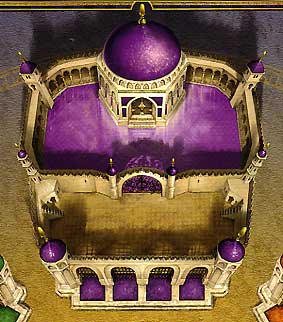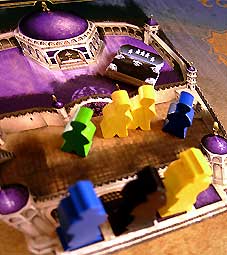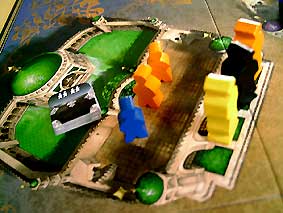Der Dieb von Bagdad / The Thief of Bagdad
Author: Thorsten Gimmler
Publisher: Queen Games / Rio Grande Games
Year: 2006
review by

| x |
|
|
|
|
|
|
|
|
|
|
|
|
|
|
|
|
|
|
|
|
|
|
|
|
|
|
|
|
|
|
|
|
|
|
|
|
|
|
|
|
|
|
|
|
|
 |
When someone has acquired a bit too much wealth, there are others who are more than willing to balance this unasked. Of course there are enough candidates to perform this noble task; take Ali and his comrades for instance, all from a well respected thieves guild. For them this is daily and hard labour: try to avoid the guards and slip into the palace unseen, climb against the walls of one of the six palaces in Bagdad, and set the owner of the treasure chest free from his sorrow with the help of our nephews, cousins and other relatives, all dependent on the measurements of the chest. This could be mistaken for plundering or theft, but in fact it is macro financial management combined with a short term demand on the goods market; the thieves guild in Bagdad has its own oriental and peculiar view on the world too. When any of the two to four players has managed to collect the required amount of treasures he has won the game.
|
| x |
|
|
|
|
|
|
|
|
|
|
|
|
|
|
|
|
|
|
|
|
|
|
|
|
|
|
|
|
|
|
|
|
|
|
|
|
|
|
|
|
|
|
|
|
|
|
The board depicts six palaces against an oriental decorated backgorund; each of the palaces is erected in a distinct and different colour. At games start the treasures are divided among the palaces; each stack consists of an increasing amount of thieves that are needed to secure the chest, starting with the lowest requirement of four thieves.
At the start of play a neutral guard is placed at one of the four available spots in front of each of the six palaces; thereafter each player may place two to four (dependant on the amount of players) own coloured guards in front of any of the palaces. These represent guards that they bribed as this is a prerequisite for a thief to enter a palace. A deck of cards depicting the six palaces is shuffled and the starting player gets six of these; any following player is dealt one to three additional cards. The thieves guild is available in the players colours and ready to meet action when a player plays one or more cards.
|
|
 |
| x |
|
|
|
|
|
|
|
|
|
|
|
|
|
|
|
|
|
|
|
|
|
|
|
|
|
|
|
|
|
|
|
|
|
|
|
|
|
|
|
|
|
|
|
|
|
 |
|
In a turn, unlimited cards may be played that each have a colour of one of the palaces; these cards move a neutral or own guard or a thief, the latter is placed at the inner court of the palace. To get a thief to enter a palace, palace cards equal to the number of neutral or foreign guards must be played. Furthermore, at least one guard of the player must be present at the palace, as well as one neutral guard. The guards of a player can also be moved to other palaces, if there still is space for them. Moving such a guard costs a palace card in the colour of either the palace the guard came from, or the colour of the palace where the guard is moved to. Together with moving a guard, a player may take a thief from the old palace, and take it to the new one with no additional costs. Moving neutral guards costs two cards instead: one in each colour of the two palaces. Players may play cards unlimited, but in a turn they may not move or deploy more than three thieves.
|
| x |
|
|
|
|
|
|
|
|
|
|
|
|
|
|
|
|
|
|
|
|
|
|
|
|
|
|
|
|
|
|
|
|
|
|
|
|
|
|
|
|
|
|
|
|
|
|
As a consequence of this, guards are moved back and forth, until enough thieves have entered a palace so a chest can be lifted; the thieves involved go back to the players stock. Now there is a next chest in the palace that needs one more thief, and thus makes it more difficult to claim it.
Three cards are drawn blind at the end of a turn; if a player forfeits any action he may take four cards, one of which is a wild card that can be used for any colour.
|
|
|
 |
|
|
|
|
|
|
|
|
|
|
|
|
|
|
|
|
|
|
|
|
|
|
|
|
|
|
|
|
|
|
|
|
|
|
|
|
|
|
|
|
|
|
|
|
Of course a player constantly lacks the right number or colour of cards, or gets hindered by a player who has placed additional guards at a palace where he was planning to bring in some thieves cheaply, with a minimum of cards. A player who is doing well, will more likely get hindered by these kind of actions from other players, but in the end self-interest prevails: how to get as fast as possible, with a minimum of cards to the next, and maybe winning chest?
|
| x |
|
|
|
|
|
|
|
|
|
|
|
|
|
|
|
|
|
|
|
|
|
|
|
|
|
|
|
|
|
|
|
|
|
|
|
|
|
|
|
|
|
|
|
|
|
 |
|
The mapboard is very moody and illustrated with lots of detail, done by Michael Menzel. Each of the palaces and the corresponding cards have a distinct symbol which makes it easy for the colour-blind to match them. As an aside must be remarked, that an increasing number of publishers take consideration with this apparently large group of grey-sighted, and in this game the matter is elegantly solved. It is already hard enough for some people to distinguish green from blue or brown from black, and what one still calls orange already is regarded as yellow for the other; apparently not everyone has been set with a calibrated colour spectrum.
|
| x |
|
|
|
|
|
|
|
|
|
|
|
|
|
|
|
|
|
|
|
|
|
|
|
|
|
|
|
|
|
|
|
|
|
|
|
|
|
|
|
|
|
|
|
|
|
|
By playing the dancer card as a wild card, card luck is reduced slightly, but to get such a card a player has to forfeit a turn. Some planning and a little tactics can be used in this game, but in the end ‘Thieves of Bagdad’ is an uncomplicated swift game with no hurdles that takes less than an hour and will attract players of any kind.
© 2006 Richard van Vugt
|
|
 |
|
Der Dieb von Bagdad / Thieves of Bagdad, Thorsten Gimmler, Queen Games / Rio Grande Games, 2006 - 2 to 4 players, 8 years and up, 60 minutes
|
  |
|
|
|
|
|
|
|
|
|
|
|
|
|
|
|
|
|
|
|
|
|
|
|
|
|
|
|
|
|
|
|
|
|
|
|
|
|
|
|
|
|
|
|
  |
|
|
|
|
|
|
|
|
|
|
|
|
|
|
|
|
|
|
|
|
|
|
|
|
|
|
|
|
|
|
|
|
|
|
|
|
|
|
|
|
|
|
|
  |
|
|
|
|
|
|
|
|
|
|
|
|
|
|
|
|
|
|
|
|
|
|
|
|
|
|
|
|
|
|
|
|
|
|
|
|
|
|
|
|
|
|
|
  |
|
|
|
|
|
|
|
|
|
|
|
|
|
|
|
|
|
|
|
|
|
|
|
|
|
|
|
|
|
|
|
|
|
|
|
|
|
|
|
|
|
|
|
  |
|
|
|
|
|
|
|
|
|
|
|
|
|
|
|
|
|
|
|
|
|
|
|
|
|
|
|
|
|
|
|
|
|
|
|
|
|
|
|
|
|
|
|
  |
|
|
|
|
|
|
|
|
|
|
|
|
|
|
|
|
|
|
|
|
|
|
|
|
|
|
|
|
|
|
|
|
|
|
|
|
|
|
|
|
|
|
|
| x |
|
|
|
|
|
|
|
|
|
|
|
|
|
|
|
|
|
|
|
|
|
|
|
|
|
|
|
|
|
|
|
|
|
|
|
|
|
|
|
|
|
|
|
|
|
Also read the  |
|
|
|
|
|
|
|
|
|
|
|
|
|
|
|
|
|
|
|
|
|
|
|
|
|
|
|
|
|
|
|
| x |
|
|
|
|
|
|
|
|
|
|
|
|
|
|
|
|
|
|
|
|
|
|
|
|
|
|
|
|
|
|
|
|
|
|
|
|
|
|
|
|
|
|
|
|
|
| x |
|
|
|
|
|
|
|
|
|
|
|
|
|
|
|
|
|
|
|
|
|
|
|
|
|
|
|
|
|
|
|
|
|
|
|
|
|
|
|
|
|
|
|
|
|
 |
|
|
|
|
|
|
|
|
|
|
|
|
|
|
|
|
|
|
|
|
|
|
|
|
|
|
|
|
|
|
|
|
|
|
|
|
|
|
|
|
|
 |
|
|
|
|
|
|
|
|
|
|
|
|
|
|
|
|
|
|
|
|
|
|
|
|
|
|
|
|
|
|
|
|
|
|
|
|
|
|
|
|
|
| x |
|
|
|
|
|
|
|
|
|
|
|
|
|
|
|
|
|
|
|
|
|
|
|
|
|
|
|
|
|
|
|
|
|
|
|
|
|
|
|
|
|
|
|
|
|
 |
|
|
|
|
|
|
|
|
|
|
|
|
|
|
|
|
|
|
|
|
|
|
|
|
|
|
|
|
|
|
|
|
|
 |
|
|
|
|
|
|
|
|
|
|
|
|
|
|
|
|
|
|
|
|
|
|
|
|
|
|
|
|
|
|
|
|
|
|
|